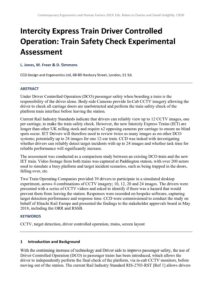| Document | Author L. Jones, M. Freer & D. Simmons |
| Abstract Under Driver Controlled Operation (DCO) passenger safety when boarding a train is the responsibility of the driver alone. Body-side Cameras provide In-Cab CCTV imagery allowing the driver to check all carriage doors are unobstructed and perform the train safety check of the platform train interface before leaving the station. Current Rail Industry Standards indicate that drivers can reliably view up to 12 CCTV images, one per carriage, to make the train safety check. However, the new Intercity Express Trains (IET) are longer than other UK rolling stock and require x2 opposing cameras per carriage to ensure no blind spots occur. IET Drivers will therefore need to review twice as many images as on other DCO systems; potentially up to 24 images for one 12-car train. CCD was tasked with investigating whether drivers can reliably detect target incidents with up to 24 images and whether task time for reliable performance will significantly increase. The assessment was conducted as a comparison study between an existing DCO train and the new IET train. Video footage from both trains was captured at Paddington station, with over 200 actors used to simulate a busy platform and target incident scenarios, such as being trapped in the doors, falling over, etc. Two Train Operating Companies provided 39 drivers to participate in a simulated desktop experiment, across 4 combinations of CCTV imagery; 10, 12, 20 and 24 images. The drivers were presented with a series of CCTV videos and asked to identify if there was a hazard that would prevent them from leaving the station. Responses were recorded on bespoke software, capturing target detection performance and response time. CCD were commissioned to conduct the study on behalf of Hitachi Rail Europe and presented the findings to the stakeholder approvals board in May 2018, including the ORR and RSSB. |

